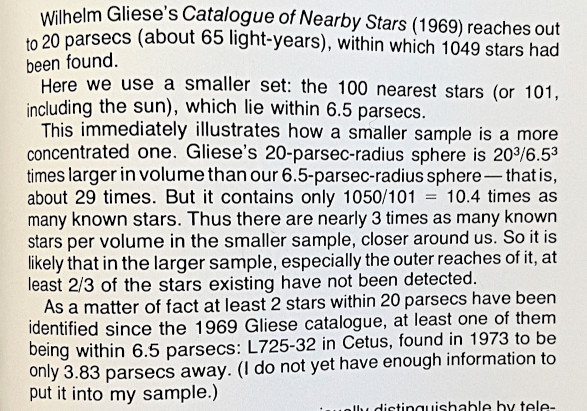
 Copyright © Michael Richmond.
This work is licensed under a Creative Commons License.
Copyright © Michael Richmond.
This work is licensed under a Creative Commons License.
This project must be done by individuals.
Astronomers have worked very hard to measure the distances to stars in the sky. For several hundred years now, scientists have always been pushing the limits and running surveys as large as they can afford.
How much has our knowledge of the very nearest stars -- the ones which should be easiest to find and measure -- changed over a few decades? Let's find out.
In 1979, Guy Ottewell published a very pretty illustrated book, The Astronomical Companion. In a section which discusses the nearest stars, he writes the following, using the best available catalog of nearby stars.

Based on this small excerpt, answer the following two questions:
Now, what about our best catalog of nearby stars in the current day, about 46 years after Ottewell's statement. The current best is the Gaia DR3 archive, which you can access freely on-line, either directly by using the "Search" tab in the above URL, or indirectly at Vizier, via the Gaia DR3 Part 1: Main source webpage. If you aren't sure how to use these resources, please visit my office hours; I'll be happy to show you.
Ottewell does a calculation to look for incompleteness: he calculates the ratio of VOLUME between a 20-pc and 6.5-pc sphere, and compares it to the ratio of STARS FOUND within those two spheres. If the density of stars is uniform in space, the two ratios should be the same.
In 1979, the ratios were 29 times more volume, but only 10.4 times as many stars. Such a large difference was a sign that our catalogs were missing lots of stars beyond 6.5 pc.
 Copyright © Michael Richmond.
This work is licensed under a Creative Commons License.
Copyright © Michael Richmond.
This work is licensed under a Creative Commons License.